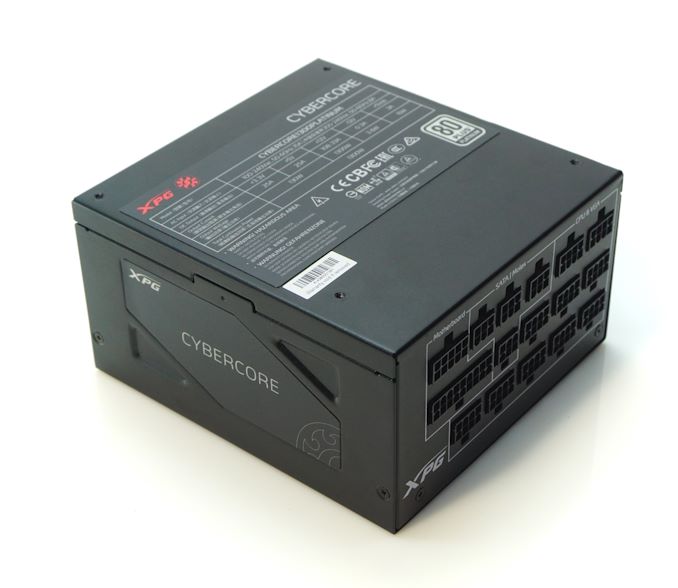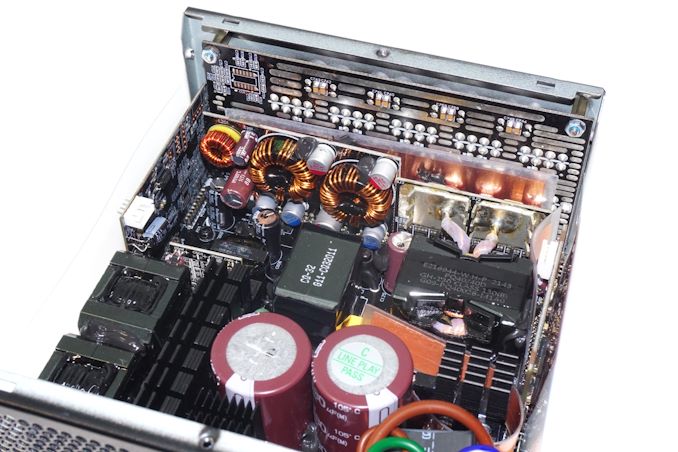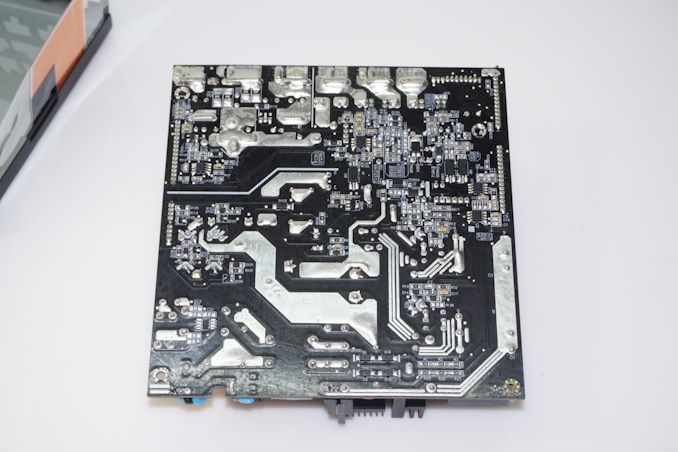The ADATA XPG Cybercore 1300W PSU Review: Advanced From the Start
by E. Fylladitakis on March 10, 2022 8:00 AM EST- Posted in
- Cases/Cooling/PSUs
- PSUs
- ADATA
- 80Plus Platinum
- XPG
- CWT
Power Supply Quality
As part of our testing, we also check output parameters are within specifications, as well as voltage ripple and line noise.
| Main Output | ||||||||
| Load (Watts) | 261.98 W | 653.57 W | 976.2 W | 1297.41 W | ||||
| Load (Percent) | 20.15% | 50.27% | 75.09% | 99.8% | ||||
| Amperes | Volts | Amperes | Volts | Amperes | Volts | Amperes | Volts | |
| 3.3 V | 2.32 | 3.35 | 5.79 | 3.35 | 8.68 | 3.33 | 11.58 | 3.32 |
| 5 V | 2.32 | 5.07 | 5.79 | 5.05 | 8.68 | 5.03 | 11.58 | 5.01 |
| 12 V | 20.07 | 12.08 | 50.16 | 12.06 | 75.24 | 12.01 | 100.33 | 11.97 |
| Line | Regulation (20% to 100% load) |
Voltage Ripple (mV) | |||||
| 20% Load | 50% Load | 75% Load | 100% Load | CL1 12V |
CL2 3.3V + 5V |
||
| 3.3V | 1.1% | 12 | 14 | 14 | 14 | 14 | 14 |
| 5V | 1% | 16 | 16 | 20 | 24 | 14 | 16 |
| 12V | 0.9% | 24 | 32 | 38 | 38 | 36 | 24 |
The electrical performance of the XPG Cybercore 1300W PSU is good, though not particularly impressive for a top-tier power supply. Voltage regulation is exceptional on all lines, holding at 0.9-1.0% across the entire nominal load range. The XPG Cybercore also displayed a maximum ripple of 38 mV on the 12V line, a lot lower than the 120 mV recommended design limit. This is a good figure for a unit that outputs 1300 Watts, but as we've seen in other PSU designs, it could have been better. The filtering on the 3.3V and 5V lines is very good, with a maximum of 14 mV and 24 mV on the 3.3V and 5V lines respectively.
Conclusion
ADATA’s massive growth was not by chance, as the company has been making precise, calculated market moves amidst their attempts at diversification. The latest release of the XPG Cybercore PSUs is another one of those great moves, as the company has brought something that truly stands out in a very competitive and saturated market.
XPG heavily advertises their collaboration with Nidec, turning it into one of the core features of the Cybercore PSU. Deservedly, having a very good cooling fan is important, especially for a PSU where it will have to contend with some very warm temperatures. Nidec’s dual ball bearing cooling fan may be a little on the loud side but it undeniably is one of the most reliable DC fans ever made. Regardless, this is not what is truly unique about the Cybercore series PSUs – not by a long shot.
The truly unique part of the Cybercore series is the new CWT platform that they are based on. The new platform is practically a game changer, as it significantly reduced the space requirements for >1 kW designs while also adding digital control. The new platform is also able to meet the Intel ATX version 2.52 requirements. Although CWT's older platform probably could meet many of the same metrics – sans the new requirement for >60% efficiency at 2% load – a better low load efficiency is a significant advantage with modern systems, as their power requirements drop vastly while they are idling. The new platform, in conjunction with XPG’s choice of parts, makes the 1300W version of the Cybercore series exceptionally efficient, easily meeting the 80Plus Platinum certification requirements.
Overall, the performance of the XPG Cybercore 1300W PSU is very good. It does not break any records, but it does not disappoint either. The XPG Cybercore delivers good power quality regardless of its load, ensuring the stability and longevity of the components it is powering. It also stays quiet while it is lightly loaded, allowing gaming systems to be built will only be meaningfully audible while gaming. The very high efficiency allows the PSU to maintain reasonable temperatures, even while its fan is turned off and it has to operate inside very warm environments.
Although it's not so much a unique trait nowadays, another very important characteristic of the XPG Cybercore is its exceptional quality. From its Nidec fan and down to the least important passive components, the XPG Cybercore is made using top quality parts. We could not spot a single component whose supplier we would classify as mediocre. Similarly, we could not find any significant design or assembly imperfections to speak of. The XPG Cybercore is built to last and that is why the company casually backs it up with a ten-year warranty.
The XPG Cybercore 1300W PSU is not without competition in its price range, but its true rival is today’s PC market. With graphics cards scarce and very expensive, few are currently building high performance gaming PCs, greatly reducing the pool of potential buyers that XPG can draw from. Consequently, the $299 MSRP is not unreasonably high for the power output and features of the PSU, although we expect that once retail availability improves, street prices will come down significantly due to the very stiff competition at this price range.













35 Comments
View All Comments
shabby - Friday, March 11, 2022 - link
Can those 2/3 slot heatsinks really dissipate that much heat?Wereweeb - Friday, March 11, 2022 - link
Water cooling will pretty much have to become the standard for flagship GPU's, even with GAA coming after 2025 (And might still take a while to reach consumer GPU's).at_clucks - Wednesday, March 16, 2022 - link
The General Appropriations Act? What does the Gaelic Athletic Association have to do with GPUs? The Georgia Alternate Assessment can't help at all here.But seriously, AMD was apparently eying Samsung's 3nm GAA for Zen5. Then again being Samsung I'm sure they probably squeeze less from GAA than TSMC is from FinFET. And I doubt that GPUs will see that anytime soon.
Einy0 - Friday, March 11, 2022 - link
If you crash from a 500 Watt transient spike and you have a normal desktop CPU with a 750 Watt or more power supply. You probably have a crappy or defective power supply.meacupla - Saturday, March 12, 2022 - link
or maybe, just maybe, nvidia is incapable of designing good power regulation circuitryinighthawki - Saturday, March 12, 2022 - link
I had a 750W PSU with a 3090 and a 5950 and it would regularly (once every few days) trigger the overcurrent protection and turn off. It was one of the best seasonic PSUs money can buy. I saw other instances of people with the same problem.The 3090 is known to hit transient spikes up to 600W, and when you couple in 100+W for the CPU, then MB, RAM, hard drives, etc. You can *trivially* go well beyond 750W.
Rοb - Sunday, March 13, 2022 - link
If you look at the efficiency ratings at 50% a Platinum will get you 92% and Titanium 94% at 50% load: https://en.wikipedia.org/wiki/80_PlusThe 2% difference translates into $2 per year for each hundred spent on electricity - so if you have a 10 year warranty (like on most Titanium rated supplies) you can probably afford to pay an extra $40 to move up a grade, and to overprovision a couple of hundred watts. It's likely that $40 won't quite cover the difference between the two power supplies but the doubling of warranty and lack of need to upgrade in the future can be worth the extra cost.
You could also just buy your power supply from the well known company that supplies components to most of the OEMs, certain models are priced very much lower than other brands; just a matter of taking the time to compare.
Byte - Sunday, March 13, 2022 - link
People also cannot imaging needing something like a 3090 that is $1500 retail. But we have it. And they sell like hotcakes. They have some crazy transient loads and 4090 might turn into an insane doozy with DOUBLE the Cudas!!!Oxford Guy - Sunday, March 13, 2022 - link
When will we stop seeing irrational designs like this PSU?The reviewer heaps praise upon a design that is suitable only if one cannot hear. Stuffing so many watts into a small box is foolish. Reliability is meaningless if you get tinnitus and noise pollution.
DanNeely - Monday, March 14, 2022 - link
Probably not until the first GPUs start shipping with them.